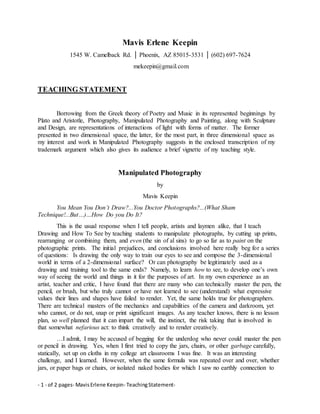
Mavis Erlene Keepin Teaching Statement for U of C
- 1. - 1 - of 2 pages- MavisErlene Keepin- TeachingStatement- Mavis Erlene Keepin 1545 W. Camelback Rd. │ Phoenix, AZ 85015-3531 │ (602) 697-7624 mekeepin@gmail.com TEACHING STATEMENT Borrowing from the Greek theory of Poetry and Music in its represented beginnings by Plato and Aristotle, Photography, Manipulated Photography and Painting, along with Sculpture and Design, are representations of interactions of light with forms of matter. The former presented in two dimensional space, the latter, for the most part, in three dimensional space as my interest and work in Manipulated Photography suggests in the enclosed transcription of my trademark argument which also gives its audience a brief vignette of my teaching style. Manipulated Photography by Mavis Keepin You Mean You Don’t Draw?...You Doctor Photographs?...(What Sham Technique!...But…)…How Do you Do It? This is the usual response when I tell people, artists and laymen alike, that I teach Drawing and How To See by teaching students to manipulate photographs, by cutting up prints, rearranging or combining them, and even (the sin of al sins) to go so far as to paint on the photographic prints. The initial prejudices, and conclusions involved here really beg for a series of questions: Is drawing the only way to train our eyes to see and compose the 3-dimensional world in terms of a 2-dimensional surface? Or can photography be legitimately used as a drawing and training tool to the same ends? Namely, to learn how to see, to develop one’s own way of seeing the world and things in it for the purposes of art. In my own experience as an artist, teacher and critic, I have found that there are many who can technically master the pen, the pencil, or brush, but who truly cannot or have not learned to see (understand) what expressive values their lines and shapes have failed to render. Yet, the same holds true for photographers. There are technical masters of the mechanics and capabilities of the camera and darkroom, yet who cannot, or do not, snap or print significant images. As any teacher knows, there is no lesson plan, so well planned that it can impart the will, the instinct, the risk taking that is involved in that somewhat nefarious act: to think creatively and to render creatively. …I admit, I may be accused of begging for the underdog who never could master the pen or pencil in drawing. Yes, when I first tried to copy the jars, chairs, or other garbage carefully, statically, set up on cloths in my college art classrooms I was fine. It was an interesting challenge, and I learned. However, when the same formula was repeated over and over, whether jars, or paper bags or chairs, or isolated naked bodies for which I saw no earthly connection to
- 2. - 2 - of 2 pages- MavisErlene Keepin- TeachingStatement- me and my life, or as the figure sitting there was such an oddity, such a throw back to something called Art, I was, in my teacher’s eyes, a failure. I wasn’t interested in the exercises. My work was not interesting, and my teachers were not interested in me. However, for some reason I persisted. In my ongoing explorations, I have come to the rather obvious conclusion that the purity of an art form, whether, it be pure drawing, or pure photography, may not always be a measure of its inherent aesthetic value. Although commercial value is often touted on this very conformity to rules of execution, a look at Art History serves to illustrate that lasting aesthetic value can never be measured on those terms. In fact, it seems that there are times when “rules are made to be broken,” when such artists as Picasso or Cezanne, to mention just two monolithic figures, are recognized as ground-breaking pioneers. One such rule which still pervades the university art schools is that a knowledge of drawing is the wire-frame or grammar without which the entire piece will fail. Yet we know that the rendering of lines and shapes, and light and shade, can be transferred to paper through several mechanical capture systems from the advent of photography to the new computer imaging systems such as AUTPCAD, or other paint programs, including the popular PhotoShop which itself undermines the old orthodox and rather comforting distinctions between photography and painting. It seems that we are either on the threshold of a new era, or else stuck on an arcane belief which could be analogous to the scholar/scribe of the 15th century who bemoaned the plebeian eye passing over an obscenely mechanical printing of The Bible. The very letters of the old way, the old 13th century sacred texts, were embellished as if the very alpha and the very omega in the texts were the “alpha and omega.” The value which my hypothetical scholar/scribe found in the hand-rendered texts was conflated with the value of the text as we understand it today. (Obtuse Derridian objections aside.) In the same way, the value of drawing is in the act of seeing that it helps to form during execution, and for which it serves to inform and audience. There is nothing inherent in the act of drawing itself that brings this about, except that drawing forces a careful placement of form with thoughtful observation, and happens to leave a trace of the movements of the recording hand. If on the other hand, we use the camera and its resulting prints to train the eye for placement and composition of form through patient observation and manipulation of prints, the art of seeing also takes place. Yes, another kind of seeing perhaps; and even if one paints on the prints, sometimes leaving a trace of movement from the hand. But all told, a seeing takes place that is quite possibly artful nonetheless.